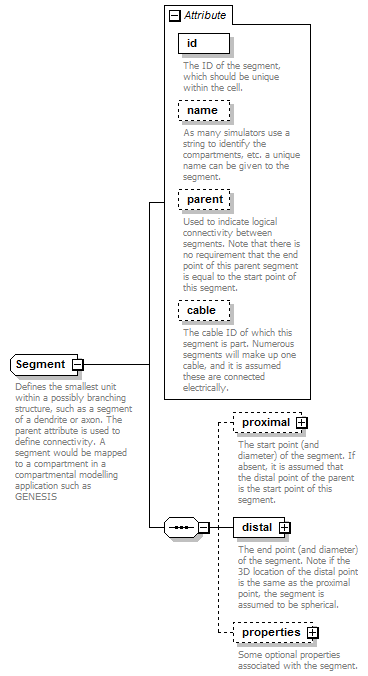<xs:complexType name="Segment">
<xs:annotation>
<xs:documentation>Defines the smallest unit within a possibly branching structure, such as a segment of a dendrite or axon. The parent attribute is used to define connectivity. A segment would be mapped to a compartment in a compartmental modelling application such as GENESIS</xs:documentation>
</xs:annotation>
<xs:sequence>
<xs:element name="proximal" type="meta:Point" minOccurs="0">
<xs:annotation>
<xs:documentation>The start point (and diameter) of the segment. If absent, it is assumed that the distal point of the parent is the start point of this segment.</xs:documentation>
</xs:annotation>
</xs:element>
<xs:element name="distal" type="meta:Point">
<xs:annotation>
<xs:documentation>The end point (and diameter) of the segment. Note if the 3D location of the distal point is the same as the proximal point, the segment is assumed to be spherical.</xs:documentation>
</xs:annotation>
</xs:element>
<xs:element name="properties" type="meta:Properties" minOccurs="0">
<xs:annotation>
<xs:documentation>Some optional properties associated with the segment.</xs:documentation>
</xs:annotation>
</xs:element>
</xs:sequence>
<xs:attribute name="id" type="meta:SegmentIdInCell" use="required">
<xs:annotation>
<xs:documentation>The ID of the segment, which should be unique within the cell.</xs:documentation>
</xs:annotation>
</xs:attribute>
<xs:attribute name="name" type="xs:string" use="optional">
<xs:annotation>
<xs:documentation>As many simulators use a string to identify the compartments, etc. a unique name can be given to the segment.</xs:documentation>
</xs:annotation>
</xs:attribute>
<xs:attribute name="parent" type="meta:SegmentIdInCell" use="optional">
<xs:annotation>
<xs:documentation>Used to indicate logical connectivity between segments. Note that there is no requirement that the end point of this parent segment is equal to the start point of this segment.</xs:documentation>
</xs:annotation>
</xs:attribute>
<xs:attribute name="cable" type="xs:nonNegativeInteger" use="optional">
<xs:annotation>
<xs:documentation>The cable ID of which this segment is part. Numerous segments will make up one cable, and it is assumed these are connected electrically.</xs:documentation>
</xs:annotation>
</xs:attribute>
</xs:complexType> |
